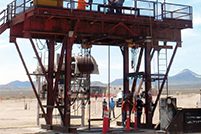Saturday, June 22, marked the end of the second phase of the Source Physics Experiment (SPE) at the Nevada National Security Site (NNSS) with the completion of the fourth and final underground, chemical explosion.
The experiment has greatly advanced U.S. abilities to detect underground nuclear explosions conducted by foreign nuclear weapons programs.
“The SPE brought together teams from across the Nuclear Security Enterprise to execute complex experiments that delivered high quality data to improve our scientific understanding of underground explosions and strengthen our Nation’s global monitoring capabilities,” said Dr. Brent K. Park, NNSA’s Deputy Administrator for Defense Nuclear Nonproliferation.
Research teams from NNSS, Los Alamos National Laboratory, Lawrence Livermore National Laboratory, Sandia National Laboratories, and the University of Nevada-Reno collected data about the unique signatures generated by this experiment using high-resolution accelerometers, seismometers, infrasound sensors, and high-speed video.
The program began in 2011 to understand how geology – specifically granite –affected seismic waves generated by underground nuclear explosions. Phase two began in 2018 and examined how alluvium, a rock weaker than granite affects the signals.
Data collected during each phase of the SPE has helped to improve U.S. capabilities for 3D high performance computer modeling of underground nuclear explosions and enable more accurate yield estimates.
NNSA makes the seismic data collected from the SPE available to researchers around the globe for analysis via the Incorporated Research Institutions for Seismology website at http://www.iris.edu/hq/.

